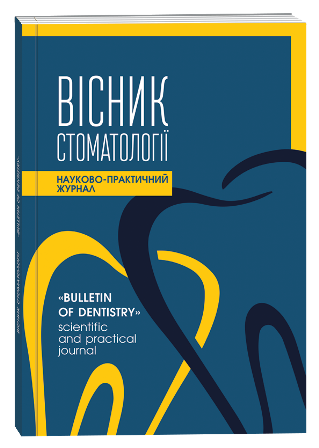DISTURBANCE OF THE PROCESSES OF MINERALIZATION OF TOOTH PULP IN RATS WITH COMBINED GUNSHOT AND NON-GUNSHOT INJURIES OF THE UPPER JAW
DOI:
https://doi.org/10.35220/2078-8916-2024-51-1.22Keywords:
gunshot wounds, maxillofacial area, experimental study, biochemical parameters.Abstract
Materials and methods of research. In order to study violations of the processes of mineralization of dental pulp in rats with combined gunshot and neognepal injuries of the upper jaw, experimental studies were conducted on White Rats of The Wistar line (males, 7 months, weight 400-450 g), which were divided into groups: intact control, a group of animals with a neognepal fracture of the upper jaw, a group of animals with a simulated gunshot wound of the upper jaw. The duration of the experiment was 28 days. The upper jaw and the pulp of teeth located outside the area of damage to the upper jaw were isolated for biochemical studies. In the course of the study, the following tasks were solved: The upper jaw and the pulp of teeth (incisors) that were outside the area of damage to the upper jaw were isolated for biochemical studies. The activity of alkaline (ALP) and acid (ACP) phosphatase was determined in the tooth pulp. Measurements of indicators in the experimental groups were carried out in 4 stages of 5 animals from the group: after 7 days of the experiment; after 14 days; after 21 days; after 28 days.The upper jaw and pulp of teeth located outside the area of damage to the upper jaw were isolated for biochemical studies. Research results. Violations of pulp mineralization processes in rats with various types of jaw injuries were established. More significant pathological changes were registered after gunshot wounds of the jaw: if at the last stage of observations, the indicators of the incisor pulp in rats after a jaw fracture corresponded to normal values, then after gunshot wounds of the jaw, the activity of destructive acid phosphatase was 1.5 times higher than the norm and the indicator after a neognepal lesion. Alkaline phosphatase activity and pulp mineralization index were lower than normal values and the level of corresponding indicators in rats after a neognepal jaw fracture. Conclusions. Violations of pulp mineralization processes in rats with various types of jaw injuries were established. More significant pathological changes were registered after gunshot wounds of the jaw: if at the last stage of observations, the indicators of incisor pulp in rats after a neognepal jaw fracture corresponded to normal values, then after gunshot wounds of the jaw, the activity of destructive acid phosphatase was 1.5 times higher than the norm and the indicator after a neognepal fracture. Alkaline phosphatase activity and pulp mineralization index were lower than normal values and the level of corresponding indicators in rats after a neognepal jaw fracture.
References
McLean, J.N., Moore, C.E., & Yellin S.A. (2005). Gunshot wounds to the face-acute management. Facial. Plast. Surg., 21, 191-198. DOI: 10.1055/s-2005-922859
Muñoz, V., Martinez, C., Echevarria, B., Fernández, M.I., Pino, A., & Anitua, E. (2018). Biological Approach for Managing Severe Gunshot Wounds: A Case Report. J Wound Ostomy Continence Nurs., 45(4), 359-363. doi: 10.1097/WON.0000000000000451.
Stefanopoulos, P.K., Pinialidis, D.E., Hadjigeorgiou, G.F., & Filippakis, K.N. (2017). Wound ballistics 101: the mechanisms of soft tissue wounding by bullets. Eur J Trauma Emerg Surg., 43(5), 579-586. doi: 10.1007/ s00068-015-0581-1.
Pinto, A., Russo, A., Reginelli, A., Iacobellis, F., Di Serafino, M., Giovine, S., & Romano, L. (2019). Gunshot Wounds: Ballistics and Imaging Findings.Semin Ultrasound CT MR., 40(1), 25-35. doi: 10.1053/j.sult.2018.10.018.
Denton, J.S., Segovia, A., & Filkins, J.A. (2006). Practical pathology of gunshot wounds. Arch Pathol Lab Med., 130(9),1283-9. doi: 10.5858/2006-130-1283- PPOGW
Thelin, E.P., Bellander, B.M., & Nekludov, M. (2015). Biochemical response to hyperbaric oxygen treatment of a transhemispheric penetrating cerebral gunshot injury. Front Neurol., 6(62) doi: 10.3389/fneur.2015.00062









